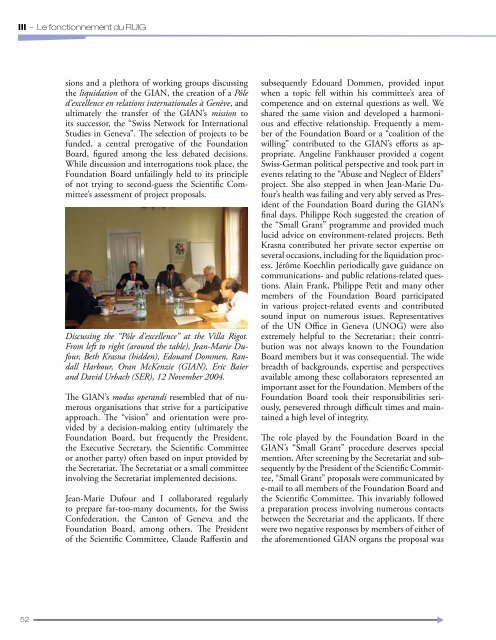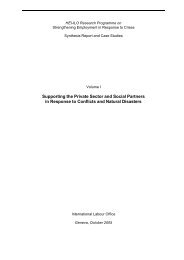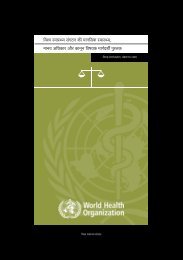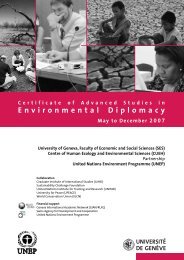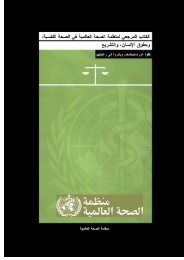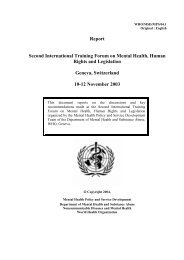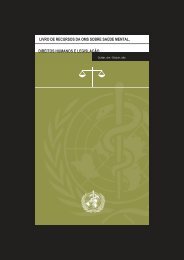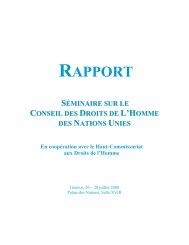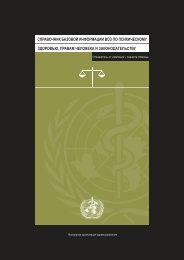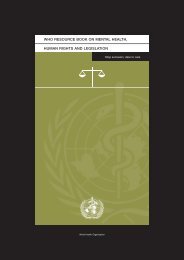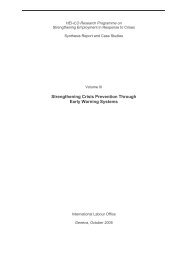Les liaisons fructueuses - RUIG-GIAN
Les liaisons fructueuses - RUIG-GIAN
Les liaisons fructueuses - RUIG-GIAN
Create successful ePaper yourself
Turn your PDF publications into a flip-book with our unique Google optimized e-Paper software.
III – Le fonctionnement du <strong>RUIG</strong><br />
sions and a plethora of working groups discussing<br />
the liquidation of the <strong>GIAN</strong>, the creation of a Pôle<br />
d’excellence en relations internationales à Genève, and<br />
ultimately the transfer of the <strong>GIAN</strong>’s mission to<br />
its successor, the “Swiss Network for International<br />
Studies in Geneva”. The selection of projects to be<br />
funded, a central prerogative of the Foundation<br />
Board, figured among the less debated decisions.<br />
While discussion and interrogations took place, the<br />
Foundation Board unfailingly held to its principle<br />
of not trying to second-guess the Scientific Committee’s<br />
assessment of project proposals.<br />
Discussing the “Pôle d’excellence” at the Villa Rigot.<br />
From left to right (around the table), Jean-Marie Dufour,<br />
Beth Krasna (hidden), Edouard Dommen, Randall<br />
Harbour, Oran McKenzie (<strong>GIAN</strong>), Eric Baier<br />
and David Urbach (SER), 12 November 2004.<br />
The <strong>GIAN</strong>’s modus operandi resembled that of numerous<br />
organisations that strive for a participative<br />
approach. The “vision” and orientation were provided<br />
by a decision-making entity (ultimately the<br />
Foundation Board, but frequently the President,<br />
the Executive Secretary, the Scientific Committee<br />
or another party) often based on input provided by<br />
the Secretariat. The Secretariat or a small committee<br />
involving the Secretariat implemented decisions.<br />
Jean-Marie Dufour and I collaborated regularly<br />
to prepare far-too-many documents, for the Swiss<br />
Confederation, the Canton of Geneva and the<br />
Foundation Board, among others. The President<br />
of the Scientific Committee, Claude Raffestin and<br />
subsequently Edouard Dommen, provided input<br />
when a topic fell within his committee’s area of<br />
competence and on external questions as well. We<br />
shared the same vision and developed a harmonious<br />
and effective relationship. Frequently a member<br />
of the Foundation Board or a “coalition of the<br />
willing” contributed to the <strong>GIAN</strong>’s efforts as appropriate.<br />
Angeline Fankhauser provided a cogent<br />
Swiss-German political perspective and took part in<br />
events relating to the “Abuse and Neglect of Elders”<br />
project. She also stepped in when Jean-Marie Dufour’s<br />
health was failing and very ably served as President<br />
of the Foundation Board during the <strong>GIAN</strong>’s<br />
final days. Philippe Roch suggested the creation of<br />
the “Small Grant” programme and provided much<br />
lucid advice on environment-related projects. Beth<br />
Krasna contributed her private sector expertise on<br />
several occasions, including for the liquidation process.<br />
Jérôme Koechlin periodically gave guidance on<br />
communications- and public relations-related questions.<br />
Alain Frank, Philippe Petit and many other<br />
members of the Foundation Board participated<br />
in various project-related events and contributed<br />
sound input on numerous issues. Representatives<br />
of the UN Office in Geneva (UNOG) were also<br />
extremely helpful to the Secretariat ; their contribution<br />
was not always known to the Foundation<br />
Board members but it was consequential. The wide<br />
breadth of backgrounds, expertise and perspectives<br />
available among these collaborators represented an<br />
important asset for the Foundation. Members of the<br />
Foundation Board took their responsibilities seriously,<br />
persevered through difficult times and maintained<br />
a high level of integrity.<br />
The role played by the Foundation Board in the<br />
<strong>GIAN</strong>’s “Small Grant” procedure deserves special<br />
mention. After screening by the Secretariat and subsequently<br />
by the President of the Scientific Committee,<br />
“Small Grant” proposals were communicated by<br />
e-mail to all members of the Foundation Board and<br />
the Scientific Committee. This invariably followed<br />
a preparation process involving numerous contacts<br />
between the Secretariat and the applicants. If there<br />
were two negative responses by members of either of<br />
the aforementioned <strong>GIAN</strong> organs the proposal was<br />
52


